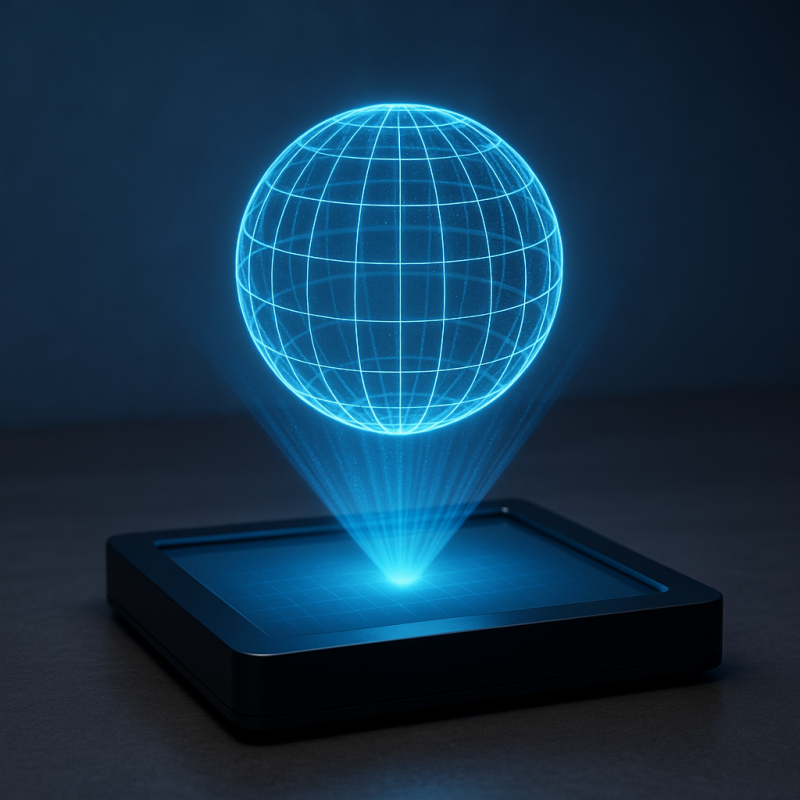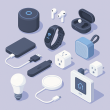Table of Contents Show
Holographic displays have come a long way since their inception, evolving from science fiction dreams to cutting-edge real-world tools. Today, you don’t need to be on the Starship Enterprise to witness a 3D, floating image suspended in space. Holography is no longer a curiosity – it’s becoming a serious contender across multiple industries. From medical imaging and education to live concerts and business meetings, the role of holographic displays is expanding rapidly.
In this article, we’ll break down how holographic displays started, the technological leaps they’ve made, where they’re being used today, and what we can expect from them in the near future. Strap in – this technology is evolving fast.
1. Early Holography: The Roots of 3D Light
The history of holography began in 1947 when Hungarian-British physicist Dennis Gabor developed the theory of holography while working on improving electron microscopes. He was awarded the Nobel Prize in Physics in 1971 for this work, even though lasers – necessary for creating holograms as we know them – hadn’t yet been invented.
When lasers arrived in the 1960s, they made it possible to create clear and detailed holograms. Early holography was purely optical and involved shining a laser on an object and recording the light interference pattern on a photosensitive plate. These early holograms were static and monochromatic – more artistic curiosity than practical tool.
Yet, even in this nascent phase, the allure of creating realistic 3D representations of objects captured the imagination of scientists and artists alike. The seeds of a 3D revolution were sown.
2. From Static to Dynamic: The Technology Evolves
Fast forward several decades, and we’ve entered an era of dynamic, digital holography. The shift from static to interactive holograms was made possible by a mix of computing power, advanced optics, and digital light projection systems.
Some of the major enabling technologies include:
| Technology | Description |
|---|---|
| Digital Light Processing (DLP) | Uses micromirrors to modulate light digitally, enabling high-speed, high-resolution projection of images. |
| Liquid Crystal on Silicon (LCoS) | Combines liquid crystal technology with reflective silicon backing to project high-resolution 3D visuals. |
| Laser Plasma Technology | Creates 3D images in mid-air using focused laser pulses that ionize air molecules, forming visible voxels (3D pixels). |
| Light Field Displays | Capture and recreate light fields to display multiple perspectives of a 3D object, enabling glasses-free viewing. |
These technologies have led to real-time rendering of full-color, high-resolution holograms that can be manipulated and interacted with in real-time. This is a huge leap forward from grainy, green-tinted static images.
In 2020, companies like Looking Glass Factory introduced light-field holographic displays that allow multiple viewers to see a 3D object from different angles without needing AR/VR headsets. This is significant because it makes holography more accessible and socially integrated – key for group communication and collaboration.
3. Holography in Entertainment: More Than Just a Gimmick
The entertainment world has always embraced spectacle, and holography is a natural fit. One of the first mainstream moments for holography came in 2012 when a hologram of rapper Tupac Shakur performed on stage at Coachella. It wasn’t a true hologram (it was actually a projection technique called “Pepper’s Ghost”), but it was close enough to stun the audience.
Since then, holograms have become more common in live performances. Artists like Michael Jackson, Whitney Houston, and Roy Orbison have “returned” to the stage via holographic concerts. These performances blend nostalgia with cutting-edge tech to create emotional, unforgettable moments.
Theme parks and museums have also leaned heavily into holographic displays. Disney’s “Star Wars: Galaxy’s Edge” features holographic characters that interact with guests, while the National Geographic Museum in Washington, D.C., has used holograms to bring extinct animals back to life.
This approach enhances storytelling and creates more immersive environments. As the quality of holography improves, expect to see even more virtual performers, interactive exhibits, and augmented theatre experiences.
4. A Game-Changer for Education
If you’ve ever tried to learn anatomy from a textbook, you know how hard it is to mentally rotate a 2D diagram into a 3D mental model. Holography changes that.
Holographic displays now allow students – particularly in science, medicine, and engineering – to interact with 3D models in real time. Microsoft’s HoloLens, for instance, enables medical students to walk around a floating hologram of a human body, peeling back layers to explore organs, muscles, and veins without ever making a single incision.
Here are just a few ways holography is transforming education:
| Application | Benefit |
|---|---|
| Medical training | Students practice surgeries or anatomy dissection virtually, reducing cost and risk. |
| History classes | Bring historical figures or events to life for immersive storytelling. |
| STEM education | Visualize molecular structures, planetary systems, and engineering models in 3D. |
| Language learning | Combine gesture, visual cues, and interaction for better retention and engagement. |
Companies like zSpace and VIVED are also producing educational holographic tools aimed at K-12 students, not just universities. As devices get cheaper and software more intuitive, expect holography to become a standard part of the digital classroom.
5. Holographic Communication: The Rise of Holo-Calls
Perhaps one of the most exciting future uses of holography is in communication. Forget Zoom – imagine sitting in your living room while your friend, boss, or doctor appears beside you as a 3D hologram.
This type of communication is already in development. Microsoft’s “Mesh” platform supports holographic meetings, where remote participants appear as avatars or holograms in shared digital spaces. Meanwhile, companies like PORTL and ARHT Media offer commercial hologram booths where people can beam into events and meetings as life-sized 3D projections.
The advantages are clear:
- Body language is preserved, improving communication and reducing misunderstandings.
- Immersion makes virtual meetings more engaging and less fatiguing than staring at a screen.
- Presence bridges emotional distance, especially useful in healthcare or long-distance relationships.
As 5G and edge computing reduce latency, real-time holographic communication will become more viable for everyday use – not just corporate showpieces.
6. Commercial and Military Use Cases
Holography isn’t just for education and entertainment. It’s also making waves in architecture, product design, defense, and even retail.
Architecture and Engineering: Holographic models allow designers to showcase buildings and structures before they’re built. Stakeholders can walk around a project, identify flaws, and suggest changes without touching a CAD file.
Retail and Marketing: Fashion brands use holograms for runway shows and storefront displays. Car companies like Lexus have used them in trade shows to show off designs in immersive 3D.
Military and Tactical Planning: The U.S. military uses holographic maps and battlefield simulation tools to strategize missions. Being able to see a real-time, 3D map of a location gives soldiers a strategic advantage that flat maps or satellite images can’t provide.
7. Healthcare and Surgical Innovation
We’ve touched on holography in medical education, but it’s also being used in actual surgical procedures.
Companies like EchoPixel are developing “mixed reality” surgical tools that turn CT and MRI scans into interactive holograms. Surgeons can plan procedures with 3D visualizations of a patient’s organs, helping them make better decisions and avoid complications.
One notable study in The Lancet Digital Health even showed that surgeons using 3D holographic visualizations reduced operation times and improved outcomes compared to traditional 2D imaging.
Hospitals are also experimenting with telemedicine using holography – doctors could consult with patients or colleagues remotely using holo-calls that preserve physical presence.
8. The Road Ahead: Challenges and Opportunities
Despite all the progress, holographic technology still has hurdles to overcome:
| Challenge | Description |
|---|---|
| Cost | High-quality holographic systems are still expensive, making widespread adoption difficult. |
| Resolution and brightness | Realistic images require high pixel density and bright displays – still a work in progress. |
| Processing power | Real-time 3D rendering demands a lot from CPUs and GPUs. |
| Interactivity | Touchless interaction (gestures, eye tracking) is still developing and not always intuitive. |
Still, the momentum is undeniable. Companies like Light Field Lab, Leia Inc., and Holoxica are investing millions in creating “true” holographic experiences without headsets or screens. For instance, Light Field Lab’s solid light display can project high-resolution objects that appear to hover in mid-air and reflect natural light.
Apple has also filed multiple patents related to holographic displays, indicating possible future integration into consumer devices like iPhones, iPads, or AR glasses.
9. Could We One Day Replace Screens Entirely?
With enough advancement, some futurists envision a world where holographic displays could replace smartphones, TVs, and even computer monitors. Instead of pulling out a device, you’d project a holographic interface into mid-air, interact with it using gestures, and close it when you’re done.
Imagine:
- A 3D GPS display floating on your dashboard.
- A holographic fitness trainer in your living room.
- Virtual home décor previews before you buy furniture.
While we’re not quite there yet, foundational steps are being taken. Consumer-grade AR glasses like Meta’s Quest Pro or Magic Leap 2 already blur the line between digital and physical worlds. Integrating true holographic capabilities into such wearables could unlock massive new functionality.
10. Final Thoughts: The Holographic Horizon
Holographic displays are no longer science fiction – they’re here, and they’re evolving fast. What began as a static optical illusion has become a dynamic tool used in industries as varied as medicine, education, military, retail, and live performance.
Still, we’re in the early days. The technology is growing rapidly, and with continued investment, broader adoption is inevitable. From ultra-realistic live performances to life-saving surgical planning, the applications are almost limitless.
The bottom line? Holography is shifting from novelty to necessity. Whether you’re a teacher, a CEO, or just a sci-fi fan, keep your eyes peeled – your next “screen” might be floating in mid-air.









